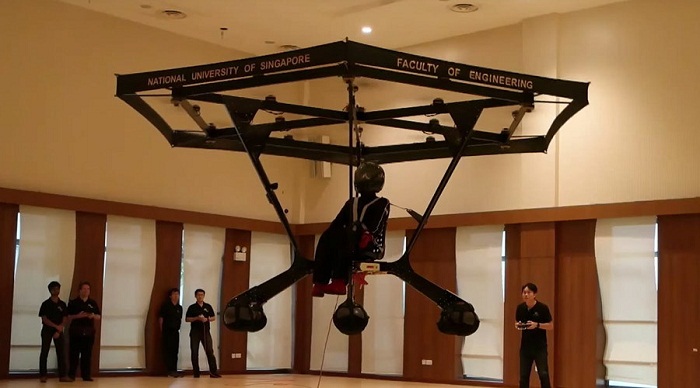The multicopter is controlled by one person, but could also transport a whole group. The vehicle has been constructed by a team of students under the auspices of FrogWorks, a collaboration between the NUS Faculty of Engineering’s Design-Centric Programme (DCP) and the University Scholars Programme (USP) for a year.
“Designing and building Snowstorm was a great learning opportunity for us,” Shawn Sim, a third year NUS Engineering student, said.
“The toughest part of this engineering challenge was ensuring a good thrust to weight ratio to allow the craft to lift a person into the air. At every stage of our design, we constantly had to balance and consider trade-offs between the types of materials, their characteristics and weight. In some instances, we even 3D-printed parts, such as our landing gear mount, just so we can have a customized and optimal fit,” he added.
The Snowstorm has 24 motors, each with 2.2 kilowatt power. Every one has a propeller with a diameter of 76 cm. The multicopter’s hexagonal frame is made of anodized aluminum beams, carbon fiber plates and tubes with Kevlar ropes.
The pilot seat is at the center of the machine and its weight is supported by six landing gear legs. Security is ensured with a five-point harness that affixes the pilot to the center of the machine.
The team has also created a system of remote controls which allow for the landing of the machine from the ground in the event that the pilot loses control.
However, the Snowstorm is just a prototype which is so far capable of carrying just one person of up to 70 kgs in weight for about five minutes. So, the team believes it is right now a recreational device rather than built for transport.
“A common trope in popular science fiction is the projection of humans flying on our own – think the Jetsons, or even Back to the Future. NUS’ Snowstorm shows that a personal flying machine is a very real possibility, primarily as a means to fulfill our dreams of flying within a recreational setting,” Dr Joerg Weigl, one of two supervisors of the project, said.
The team is going to continue it work on the project – its mechanical safety measures, propeller and motor configurations as well as control software – hoping that the improvements will bring the Snowstorm closer to commercialization.
More about:
















































